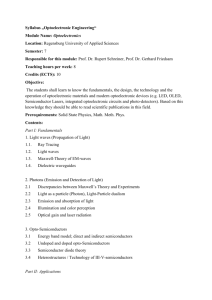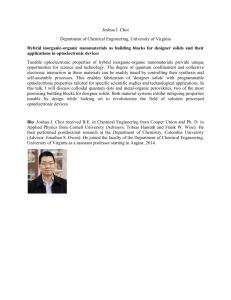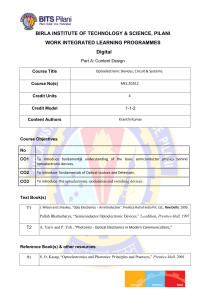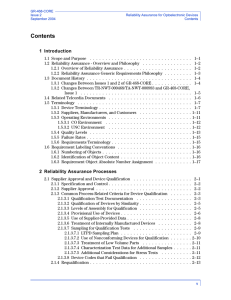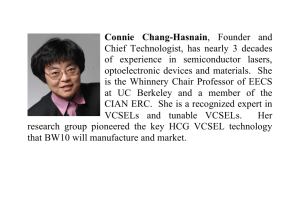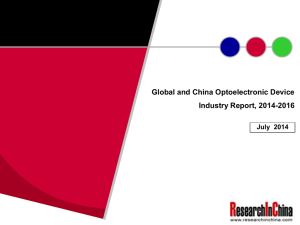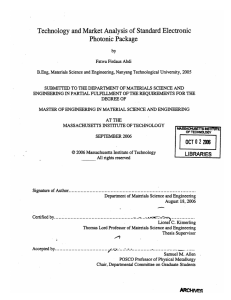Ben- Gurion University of the Negev Materials Engineering Name of
advertisement
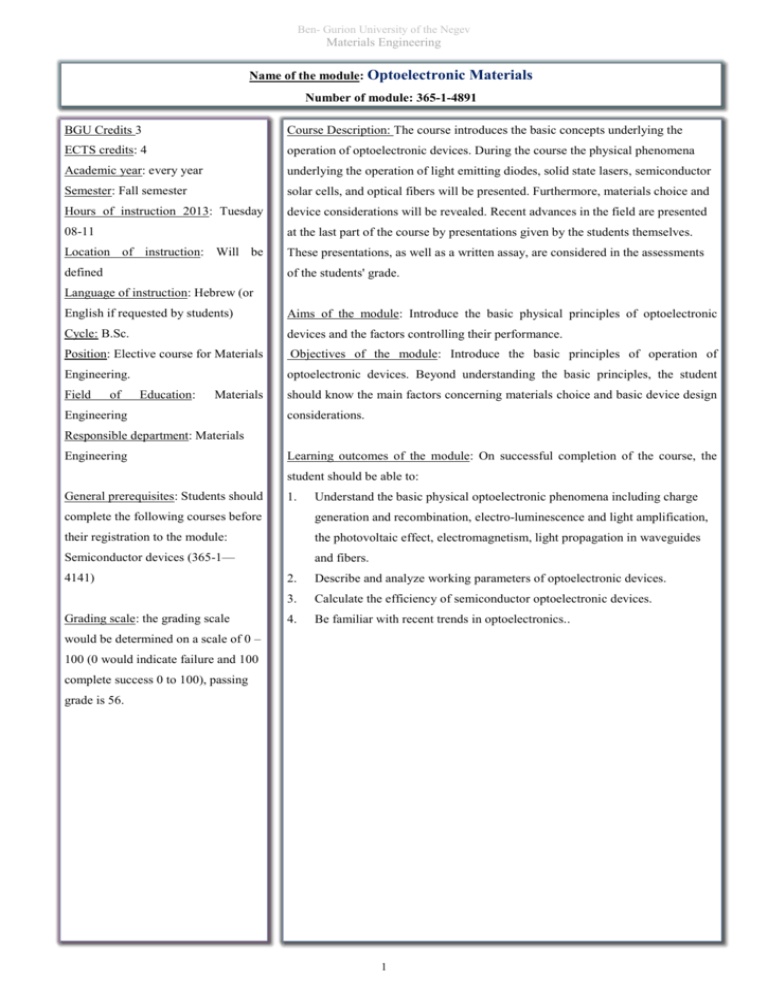
Ben- Gurion University of the Negev Materials Engineering Name of the module: Optoelectronic Materials Number of module: 365-1-4891 BGU Credits 3 Course Description: The course introduces the basic concepts underlying the ECTS credits: 4 operation of optoelectronic devices. During the course the physical phenomena Academic year: every year underlying the operation of light emitting diodes, solid state lasers, semiconductor Semester: Fall semester solar cells, and optical fibers will be presented. Furthermore, materials choice and Hours of instruction 2013: Tuesday device considerations will be revealed. Recent advances in the field are presented 08-11 at the last part of the course by presentations given by the students themselves. Location of instruction: Will be These presentations, as well as a written assay, are considered in the assessments defined of the students' grade. Language of instruction: Hebrew (or English if requested by students) Aims of the module: Introduce the basic physical principles of optoelectronic Cycle: B.Sc. devices and the factors controlling their performance. Position: Elective course for Materials Objectives of the module: Introduce the basic principles of operation of Engineering. optoelectronic devices. Beyond understanding the basic principles, the student Field of Education: Materials Engineering should know the main factors concerning materials choice and basic device design considerations. Responsible department: Materials Engineering Learning outcomes of the module: On successful completion of the course, the student should be able to: General prerequisites: Students should 1. Understand the basic physical optoelectronic phenomena including charge complete the following courses before generation and recombination, electro-luminescence and light amplification, their registration to the module: the photovoltaic effect, electromagnetism, light propagation in waveguides Semiconductor devices (365-1— and fibers. 4141) Grading scale: the grading scale 2. Describe and analyze working parameters of optoelectronic devices. 3. Calculate the efficiency of semiconductor optoelectronic devices. 4. Be familiar with recent trends in optoelectronics.. would be determined on a scale of 0 – 100 (0 would indicate failure and 100 complete success 0 to 100), passing grade is 56. 1 Ben- Gurion University of the Negev Materials Engineering Lecturer: Professor Nurit Ashkenasy Attendance regulation: Attendance in class is mandatory (80% of classes). Contact details: Building 59, room Attendance in students seminars is mandatory (100% of classes). 11 Teaching arrangement and method of instruction: Lectures and exercises. Office phone: 08-6472494 Email: nurita@bgu.ac.il Office hours: Assessment: will be announced. how the students will be assessed in the module 1. Assignment table of content 10% Module evaluation: at the end of the 2. Seminar 45% semester the students will evaluate 3. Written assay 45% the module, in order to draw 100% conclusions, and for the university's internal needs. Work and assignments: The students are expected to follow classes by looking over was the lecture notes, and supplement by reading in the text –book of the course, as well confirmed by the faculty academic as complementary literature. The students will prepare a written assay (10 pages) advisory committee to be valid on and oral presentation (20 minutes) on an advanced topic related to the course 2012-2013. outline. Last update: February 5, 2013 Time required for individual work: in addition to attendance in class, the students Confirmation: the syllabus are expected to do their assignment and individual work: 1 h per week for the first half of the semester, and 5 hours per week during the second part of the semester. Module Content\ schedule and outlines: 1. 2. 3. 4. 5. 6. Introduction: p-n junction, charge generation and recombination in semiconductors (3h). Solar cells: the photovoltaic phenomena, short circuit current, open circuit voltage, photocurrent and diode characteristics the solar spectrum, , the fill factor, solar cell efficiency, the equivalent circuit, basic device architecture, hetero-junction and tandem cells (6h). Light emitting diode (LED): electroluminescence principles, internal and external yield, output spectral characteristics, modulation bandwidth, surface and edge LED, double heterostructure, materials choice (4h). Laser: light amplification, population inversion, the laser cavity, Einstein relations, the lasing condition, threshold gain, spectral bandwidth and laser modes, HeNe laser, basic SC laser device, the threshold current, power and efficiency, single mode laser, advanced cavities (DFB, CCC lasers, quantum well lasers (8h). Optical fibers: light propagation, total internal reflectance, the wave guide condition, light intensity distribution and fiber modes, the V number, dispersion in waveguide and fibers, multimode and single mode fibers, the GRIN fiber, signal attenuation, fiber fabrication (6h) Advanced topics (students presentations) (9h) Required reading: Optoelectronics and Photonics principles and applications - S. O. Kasap Additional literature: articles and journals in the field * Learning material will be available to the students on the module's website (high-learn)/ library/ electronic documents available to BGU students. 2
